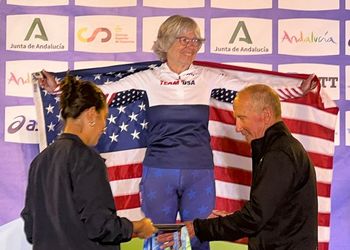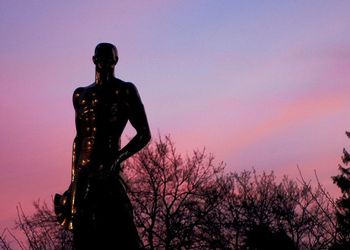Feature: Are You A Cancer Survivor?

YOU MIGHT THANK MSU AND BARNEY ROSENBERG
Not only did an MSU scientist discover the world’s leading anti-cancer drug, but his breakthrough resulted in royalty income that continues to advance research and the transfer of technology from MSU to the world. . . . Barney Rosenberg, with his bacterial cells and electrodes, and his curiosity, imagination and persistence, may have saved the lives of more people than most of the cancer researchers in the world put together. –Gregory A. Petsko, professor of chemistry and biochemistry at Brandeis University and former president of the American Society for Biochemistry and Molecular Biology.
While cancer is still too often a killer, people are no longer surprised when someone survives a serious cancer. One reason is the serendipitous discovery at MSU of two platinum drugs by Barnett “Barney” Rosenberg in the 1970s. The drugs, cisplatin (Platinol) and carboplatin (Paraplatin) don’t stand out because they are rarely used alone. But they are key ingredients in many of the combinations of drugs, radiation and surgery that make cancers survivable, according to the director of clinical research at one of the world’s top cancer hospitals.
“(Cisplatin) became the backbone of combination therapy for testicular, bladder, lung, ovarian, head and neck, and gastric cancers, and most recently, for triple negative breast cancer and a number of other less common tumors,” Bruce A. Chabner wrote in Rosenberg’s obituary published in Cancer Research. “(Cisplatin) analogues carboplatin and oxaliplatin (developed in Japan) have further extended this range of benefit. The patients cured by these regimens and those that have benefitted from this therapy number in the millions.”
Chabner directs clinical research at the Massachusetts General Hospital Cancer Center. He previously directed the Division of Cancer Treatment at the National Cancer Institute. The discovery is clearly one of the greatest milestones in the history of MSU research, if not the greatest. Not only can it be measured in number of lives saved, but also in hundreds of millions in royalty income to the MSU Foundation—money that is being invested in current research and technology transfer efforts.
The story of Barney Rosenberg remains a compelling saga that, to this day, stands as a beacon to the value of science and research. Rosenberg came to MSU in 1961 at a time when scientists were rapidly gearing up for “the war on cancer,” as it became known as during the Nixon administration. But “Barney,” as he was known to colleagues, wasn’t one of them. He wasn’t a physician, not even a biologist. He was a physicist. Actually it might be best to describe Rosenberg simply as a “scientist.” Or perhaps, the “compleat scientist” because of his wide-ranging knowledge in many areas.
In an oral history interview, he was asked what sparked his interest. “Initially, it came about by virtue of reading an encyclopedia that was on the market at the time, starting with page one,” he says. “The most interesting things to me were the articles that had to do with science. I knew then at a very early age—I’m talking now six and seven—that I was going to be a scientist.”
Rosenberg was born in 1926 in New York City and grew up there. He attended Lincoln High School in Brooklyn and, after Army service in the Philippines, went on to Brooklyn College, earning a B.S. degree in physics in 1948. Then it was off to New York University to study physics under Hartmut Kallman, who had been a student under Albert Einstein, making Rosenberg an academic grandson of Einstein. After receiving a master’s degree in 1950 and a doctorate in 1955, he worked as a researcher at Westinghouse in New Jersey. Up to then, his research had been in solid state physics and he had received patents in that area. But it no longer fascinated him. He was intrigued by the up-and-coming field of biophysics and returned to NYU to do research in that area under a government contract.
Ritta Rosenberg, Barney’s widow, recalls that during this time he attended a fateful science conference in Sweden. There he first met Leroy Augenstein, a physicist at Brookhaven National Laboratory, and Ronald Mason, an English scientist who is now Sir Ronald. She says the three men found they had similar interests and aspirations and decided they would try to start a department of biophysics at a university. Following up, they submitted proposals to four universities. After campus visits, Augenstein and Rosenberg (Mason dropped out of the trio) were invited in 1961 to come to MSU and the University of California, Berkeley. They chose MSU.
Ritta Rosenberg says her husband was enchanted with MSU in that it was so pleasantly different from New York City campuses. She recalls him calling her long distance during an interview visit. (Such calls were somewhat special then.) He wanted to tell her how fascinated he was to observe a group of male students who were out serenading sororities. In his oral history though, Rosenberg said, “The reason why we took the offer from Michigan State rather than any of the other four major universities was because of John Hannah. He made a very simple statement. ‘You do what you want to do. There are no restrictions on you. Set up any system you want. You’re totally free.’ Now, that’s a statement you rarely ever get.”
Having no restrictions, Rosenberg and Augenstein decided to make the department for graduate work only, which allowed them to concentrate on research. “This was the dominant thing,” he recalls. “Biophysics was just beginning and therefore research was the most important aspect of it. So, John Hannah’s freedom that he offered us was the deciding factor. . . . “And it was that complete freedom that allowed me to do the experiments that led to the discovery of the cisplatin drug and the anti-cancer activity. Had I not had that freedom, I never would have.”
Augenstein, who was named chair of the department, was doing research on brain function, but it was his charisma that shaped his subsequent career. He was extraordinarily good at communicating science issues to non-scientists and later used that ability to prepare the public for the coming genetics revolution. He made television documentaries and spoke to church and civic groups around the state. Augenstein also became active in politics. He was elected to the Michigan Board of Higher Education and was said to be considering a run for the U.S. Senate. All that came to an end in 1969 when he died in the crash of the small plane that he flew to speaking engagements.
After arriving at Michigan State, Rosenberg could choose from a long list of research topics that were of interest to him. One of his first choices was in the area of vision, an earlier interest at Westinghouse. He said the central question was, “How does a photon of light entering into the eye and being absorbed trigger off a neurologic reaction in the brain that tells you you’ve seen something? This was the problem we attacked.”
Rosenberg soon had a cadre of graduate students serving as research assistants and they tackled other areas such as the physical properties of proteins and their ability to conduct electricity, an important function in biological systems. He also started studies of the process of aging.
He started his cancer research without knowing he was doing so, at least not explicitly. Rosenberg had become intrigued with the fact that when cells divide, the pattern they make is much like that of a magnetic field—“what you would see if you took a bar magnet, put a piece of paper on it and sprinkled it with iron filings. It’s a dipole field. “So when I first saw these pictures of a cell in division and they reminded me so much of the dipole field, I thought, ‘Well, is it possible that the dipole field may be involved in the division process?’ This turned out to be not an original idea on my part.



